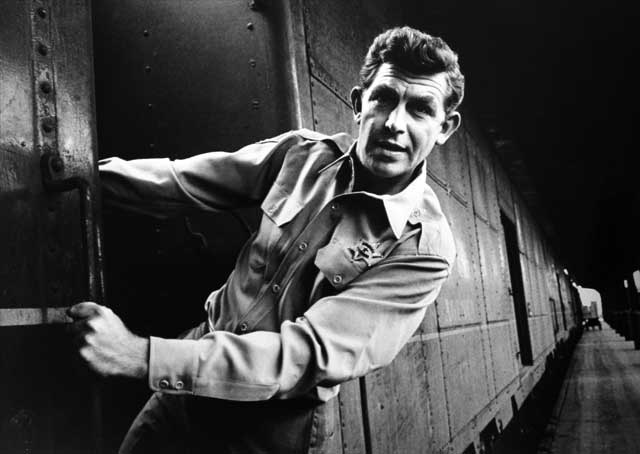“Andy Griffith, an actor whose folksy Southern manner charmed audiences for more than 50 years on Broadway, in movies, on records and especially on television—most notably as the small-town sheriff on the long-running situation comedy that bore his name—died on Tuesday at his home on Roanoke Island in North Carolina,” reports Douglas Martin in the New York Times. Griffith was 86.
He “was already a star, with rave reviews on Broadway in No Time for Sergeants and in Elia Kazan’s film A Face in the Crowd, when The Andy Griffith Show made its debut in the fall of 1960. And he delighted a later generation of television viewers in the 1980s and ’90s in the title role of the courtroom drama Matlock. But his fame was never as great as it was in the 1960s, when he starred for eight years as Andy Taylor, the sagacious sheriff of the make-believe Southern town of Mayberry, running weekly herd on a collection of eccentrics like his ineffectual deputy, Barney Fife, and the simple-minded gas station attendant Gomer Pyle while, as a widower, patiently raising a young son, Opie.”
Opie was played, of course, by director and producer Ron Howard, who tweets, “Andy Griffith His pursuit of excellence and the joy he took in creating served generations & shaped my life I’m forever grateful RIP Andy.”
“It’s been half a century since A Face in the Crowd had its premiere, but there’s a sense in which this 1957 Elia Kazan flick remains the founding movie of postmodern times,” wrote J. Hoberman in the Voice in 2008. Griffith plays “a terrifyingly avid TV star named Lonesome Rhodes” who advises a lame presidential candidate. “Performer, tribune, and member of the audience, Rhodes is a focus group of one—as well as the personification of TV and, before the movie ends, a big-time threat to American democracy. A Face in the Crowd is essentially a political horror film. It’s not funny enough to work as satire, a bit doggedly literal for allegory, yet too hyperbolic to convince as drama. Nor was it a hit. As political rhetoric, however, A Face in the Crowd has never ceased to be relevant. Darkly alluded to during the 1960 campaign (decided, so people thought, by a television debate), it was quasi-remade as Wild in the Streets, American International’s contribution to the madness of 1968, re-released (with a nod to George Wallace) in 1972, invoked to explain Watergate in 1974, and reconfigured as Nashville in 1975.”
Updates: “A Face in the Crowd could have drawn its creative inspiration only from below the Mason-Dixon line, in the country’s moist loins,” wrote James Wolcott for Vanity Fair back in 2007 (via Movie City News). “Andy Griffith, fresh from making comedy records such as What It Was, Was Football and cradling a beat-up guitar that he calls ‘momma,’ can’t compete with Newman, Holden, and Brando in the hairless-chest, backwoods-Apollo category—who can? But he owns a thick mop of curls that screams virility, contrasted against the bald gents infesting the executive suites…; flaunts a winning manner (his best scenes are the quieter, joshing ones); and cavorts with a lusty energy reminiscent of Burt Lancaster bending invisible bars of steel.”
“The Siren, along with most cinephiles, reveres A Face in the Crowd, but for the larger public the apotheosis is The Andy Griffith Show. Reruns were the Siren’s after-school routine. Cookies, milk, Andy, Barney, Opie and Aunt Bea. She didn’t identify with the milieu all that much; she had relatives in small-town Alabama, but to say that Mayberry is idealized is like saying not all town drunks are as lovable as Otis. But she thought it was glorious then, and still does. She has a few favorites—like the one where Opie kills a mother bird and Andy makes him nurse the fledglings, which stays with you for the same reason The Yearling stays, because it shatters your heart to powder.”
Matt Zoller Seitz for Vulture on the series: “Although Griffith was usually the calmest person in the room, he was never dull. He was a great listener who made it seem as though Andy loved the humanity in the town’s residents even when they irritated him to no end. The way Griffith played Andy, you just knew that he was a social person who treated police work as a chance to watch folks be themselves.”
For Movies.com, Scott Weinberg picks out “Five Essential Movies.” More from Susan King (Los Angeles Times) and Sean O’Neal (AV Club).
For news and tips throughout the day every day, follow @KeyframeDaily on Twitter and/or the RSS feed. Get Keyframe Daily in your inbox by signing in at fandor.com/daily.




